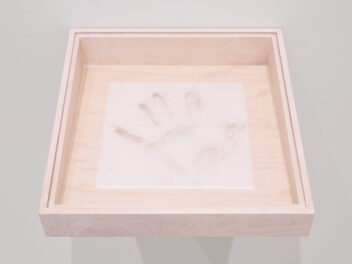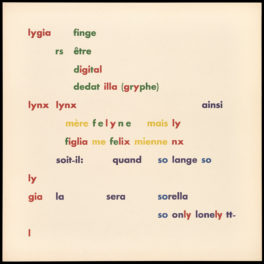
Diagram of the Bauhaus curriculum (adapted, right), 1922, Walter Gropius. Lithograph. 20.2 x 29.3 cm. From Walter Gropius, Satzungen Staatliches Bauhaus in Weimar (Statutes of the State Bauhaus in Weimar), July 1922. Bauhaus Typography Collection, 1919–1937. The Getty Research Institute, 850513. © 2019 Artists Rights Society (ARS) / VG Bild-Kunst, Bonn
“The best education is one’s own experience.”
—Josef Albers, “Teaching Form Through Practice,” 1928
When Walter Gropius diagrammed the Bauhaus curriculum in 1922, he envisioned a school organized around the mastery of design and craft through a set of core materials: wood, metal, textiles, glass, clay, stone, and color. Paper was not listed, nor did Gropius consider it a mode of production or way of working that constituted a true craft.
Instead, paper was considered a “preliminary” material, studied by first-year students through design exercises in the beginners’ course. The paper study models included in the exhibition Bauhaus Beginnings at the Getty Research Institute are a small sampling of these student works produced during the years 1926 to 1929 under the direction of Josef Albers. The downloadable Albers-inspired paper-study exercise in the accompanying online exhibition Bauhaus: Building the New Artist invites you to try your hand at Bauhaus work.
Albers conceived of these paper exercises as an experimental approach to arts education that cultivated the student’s direct, unmediated experience of materials. The student would work directly by hand, “without method and without tools.”(1) The exercise restricted students to a simple material, paper or cardboard, which they used to render three-dimensional study models.
These study models were not produced in preparation for a specific area of expertise, nor were they intended to lead directly to the core crafts such as woodworking or textiles. Instead, they were seen to serve as a preliminary exercise in the cultivation of students’ experience with materials.
Acquiring a Feeling for Materials
Despite paper’s status as a preliminary material, Albers encouraged students to consider paper as having distinct qualities. He required them to acquire a feeling for materials in order to heighten their intuition of paper’s imperceptible qualities. In his 1928 lecture discussing the pedagogical approach at Bauhaus, Albers noted:
For example, outside the school, in industry and the crafts, paper is usually used as a flat sheet and is glued, which means that one side often loses its expressiveness and the edge is hardly ever used. We take this as our cue to use both sides of the paper, in an upright, folded, or sculptural manner, with emphasis on the edges… We then test its resistance to the forces of tension and compression.”(2)
For Albers, paper was not merely a pliable plane, but a material of consequence, containing edges, sides, and even physics, requiring not just shaping and sculpting but testing through physical touch.

Materialübung (Material Study), ca. 1927–28, Albert Renger-Patzsch. Gelatin silver print, 17.1 x 23 cm. The Getty Research Institute, 850514.54. © 2019 Albert Renger-Patzsch Archiv / Ann u. Jürgen Wilde, Zülpich / Artists Rights Society (ARS), New York
The photograph above by Albert Renger-Patzsch reveals the experimentation in testing and touching at play in the formation extending to other material studies such as wood. In the image, the wood study model is turned 45 degrees to allow a simultaneous view of all three faces of the composition. This is an approximation of the mechanical view of axonometric drawing favored by architects of this time.
The study model is assembled of rigid wood sheets set into a composition of interlocking planes. A single dark strip of rigid wooden cantilevers from a white plinth while simultaneously suspending a small series of squares—possibly demonstrating the durability of paper in resisting gravity and loads.
At the center of the composition, a tower is produced through strips of what appear to be thin plywood, whose thickened edges are highlighted by direct light. In fact, most of the photographs of Albers’s student exercises are staged with lighting that emphasize the edges of paper sheets, as well as their formal planar composition.

Material exercises in paper, ca. 1928–29, Alfred Ehrhardt, photographer. The Getty Research Institute, 850514. © Alfred Ehrhardt Stiftung
Another material study photographed by student Alfred Ehrhardt reveals a similar attention to lighting and shadow play. Several paper models are positioned and cast in light so as to elicit a rhythmic quality. In this careful lighting study, the figures of the cast shadows are emphasized and the surfaces of the sheets alternate between white paper and dark shadow in a rhythmic play. The graphic qualities of the cut surface are emphasized over its structural possibilities, yet some architectural readings are suggested. The study models are propped up and clustered as though forming architectural towers, and the conic model on the right side is slit open with an accordion fold that suggests stairwells leading into a building.
Developing the Artist’s “Inner Feeling”
Students produced hundreds of paper study models as disposable exercises, which were like sketches of experience in three dimensions. The purpose of paper study models was not merely to organize these experiences, but to condition the tactile senses. For example, Albers’s predecessor Moholy-Nagy asked students to organize found materials along a spectrum of haptic qualities, from smooth to rough, sharp to dull. Students catalogued materials into categories of touch, reading the paper surface by hand. Albers extended this exercise by limiting students to one single material such as paper.
Shaped by the actual or perceived limitations of the paper material, students could therefore develop an inner feeling for their handling. Such inner feeling needed to be trained rigorously, by working directly by hand, and be allowed to develop without influence, without the predetermination of method and tools.
“Without method and without tools” was the preferred mode of teaching for Albers, who sought to teach amateurs to remain amateur, rather than convert them into experts. As Albers stated, “Amateurism is an emptiness and I accept it because it has no preconceived ideas or rules to be applied. This is for me a most welcome situation and I like to keep my students amateurs and dilettantes.”(3)
In other strains of German architectural education, amateurism through modeling (without method and without tools) similarly vied for a space of predilection in the procedures of design. In his text “On Designing” (Vom Entwerfen, 1921), Berlin-based pedagogue Wassili Luckhardt instructed the student reader embarking on a new design to “put pencil and paper aside, take clay or plasticine and begin modeling, from scratch, directly and without influence.”
According to Luckhardt, modeling by hand without influence was the first step toward a student’s rehabilitation from the technical arts, which tended to cultivate design through the facility of instruments—its pencils, rulers and compass—rather than intuition. Luckhardt continues: “Take away rule and compass from today’s architects and eighty percent may have to give up their profession. If only they would do so.”
Whereas drawing with measurement was the professional activity of the technical expert, working by hand without influence was the technique of the reformed designer, a method that was uninhibited by instruments or standards attached to the development of the professional title.
Learning to Trust Experience
“The best education is one’s own experience.” What did Albers mean when he called for students to develop an “experience” of materials? This notion of “one’s own experience”—the idea that the subjective experience of an individual can serve as a foundation for knowledge—harkens back to the eighteenth century, when experience and experiment were closely connected. “Experience” designated a way of knowing the world through testing and observation. Experiments were designed to replicate natural phenomena; the witnessing of a natural event constituted scientific knowledge itself.
By the nineteenth century, the term experience had become the consideration or reflection of an observed event.(4) Albers’s notion of experience contains this idea of an observed event, or a lesson gained from the past and through direct observation; in this case, a lesson that has been elevated to the form of artistic consciousness.(5)
By working directly by hand and without mediation from tools or instruments (only scissors and reluctantly glue was allowed as a secondary stage of experimentation), the exercises Albers developed around the construction of the paper study models in the Bauhaus basic course emphasized the cultivation of the new artisan through a material pedagogy that linked human perception with direct bodily experience.
Notes
1. “Of course, we have a good variety of tools and other small machines in our basic workshop, but they are kept away from the students at first, especially at the beginning of a new chapter in the work with materials. This forces us to begin thinking and doing on our own without a theoretical introduction, without method and without tools.” Josef Albers, “Teaching Form Through Practice,” AA Files, No. 67 (2013): 129. This lecture is originally from VI Internationaler Congress für Zeichnen, Kunstunterricht und Angewandte Kunst in rag, 1928. In 2013, AA Files published a revised version of a translation first published in Hans M. Winglet, Bauhaus: Weimar, Dessau, Berlin, Chicago (Cambridge, MA: MIT Press, 1969). Another version of the lecture was published under the title ‘Werklicher Formunterricht’ in the journal Bauhaus vol 2, no 2/3, 1928. )
2. Josef Albers, “Teaching Form Through Practice,” 130.
3. John H. Holloway, John A. Weil, and Josef Albers. “A Conversation with Josef Albers.” Leonardo 3, no. 4 (1970): 459–64.
4. See Raymond Williams, “Experience” in Keywords: A Vocabulary of Culture and Society. (New York: Oxford University Press, 1976) 126-129.
5. More a history of artistic knowledge as developed on the foundations of bodily experience in the Bauhaus, see Zeynep Celik Alexander, Kinaesthetic Knowing: Aesthetics, Epistemology, Modern Design. (Chicago: University of Chicago Press, 2018), 10-11.




It’s amazing how much a pliable material paper can be. I can see how interlocking rigid wooden sheets provides a template for what you can do with the physics of paper. I admire Albers teaching methods and knack for design through uninhibited, creative flair.
Teaching Form Through Practice by Josef Albers has become my daily guide in the classroom. For their historical reviews, my students analyzed the Hannes Beckmann’s article “Formative Years” (1970) and his references to the style and method Albers used for teaching. Remarkable sequence of formal transformations and material.
https://essaydune.com